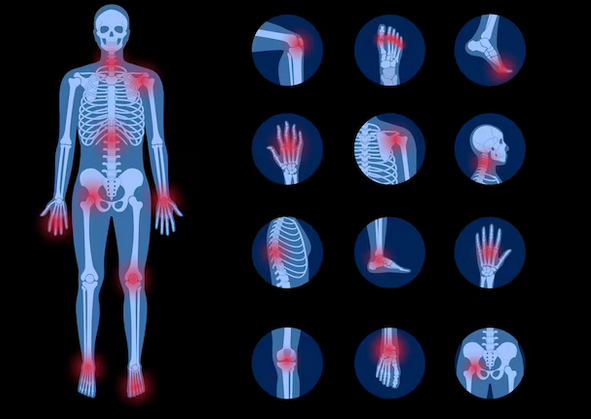What is rheumatoid arthritis causes and symptoms ??
Rheumatoid arthritis causes and symptoms ??
What is rheumatoid arthritis ??
Rheumatoid arthritis (RA) is a chronic autoimmune disease that primarily affects the joints, causing inflammation, pain, and eventually leading to joint damage if left untreated. Unlike osteoarthritis, which is caused by wear and tear on the joints, RA occurs when the body’s immune system mistakenly attacks the synovium—the lining of the membranes that surround the joints.Rheumatoid arthritis is one of the most common inflammatory disorders with not only the joint but a wide range of extra articular organs. Early treatment is not possible and will lead to progressive joint deformity and increase morbidity and mortality. It increased co- morbidity and mortality include infection renal impairment cardiovascular disease and lymphomas.

Etiology and pathophysiology
-Hormonal factor
– Genetic factor
– Environmental factors
– Cigarette smoking
-Infiltrate a variety of inflammatory cells into the joints.
Clinical manifestation
Disease onset is usually insidious with the predominant symptoms being pain, stiffness and swelling.
Affected area are
– The metacarpophalangeal and proximal interphalangeal joints of the fingers.
-Interphalangeal joints of the thumbs.
-The warts
-Metatarsophalangeal joints of the toes.
-Joints of upper and lower Limbs such as the elbows, shoulders and knees.
-Myalgia, fatigue, low grade fever, weight loss.
Symptoms
- Joint pain and stiffness: Typically affects smaller joints first (e.g., fingers and toes) and can spread to larger joints over time.
- Swelling: Inflamed joints can become swollen, warm, and tender to the touch.
- Fatigue: Many people with RA experience persistent fatigue and a general feeling of being unwell.
- Morning stiffness: Stiffness that lasts for more than 30 minutes after waking up is common.
- Symmetry: RA often affects joints symmetrically (e.g., both wrists or both knees).
Causes
The exact cause of RA is unknown, but it is believed to involve a combination of genetic predisposition and environmental factors, such as infections or smoking, which may trigger the immune system to attack the joints.
Diagnosis
RA is diagnosed based on symptoms, physical exams, blood tests, and imaging studies. Blood tests often look for rheumatoid factor (RF) or anti-cyclic citrullinated peptide (anti-CCP) antibodies, which are commonly found in people with RA. Imaging, such as X-rays, ultrasounds, or MRIs, can help assess the extent of joint damage.
Need proper diagnosis
Rheumatoid arthritis diagnose made based on
– Patient history
– Presenting symptoms
– Clinical finding
– Ultrasound for the presence of synovitis and X-rays
– Later demonstrate joint destruction
American rheumatism Association made a criteria for the diagnosis of rheumatoid arthritis.
- Morning stiffness in and around the joints for at last 6 weeks lasting at least 1 hour before maximal improvement.
- Swelling of 3 or more joints for at least 6 weeks
- Swelling of the wrist, metacarpophalangeal or Proximal interphalangeal joints For at least 6 weeks.
- Symmetric joint swelling for at least 6 weeks.
- Hard X rays changes typical of rheumatoid arthritis that must include erosion or unequivocal bony decalcification around the joints.
- Rheumatoid subcutaneous nodules.
- Positive Rheumatoid factor
The presence of at least 4 of these indicator a diagnosis of rheumatoid arthritis.

Treatment
There is no cure for RA, but various treatments can manage symptoms and slow disease progression:
- Medications: These include nonsteroidal anti-inflammatory drugs (NSAIDs), corticosteroids, disease-modifying antirheumatic drugs (DMARDs), and biologic agents that target specific parts of the immune system.
- Physical therapy: Helps maintain joint flexibility and muscle strength.
- Lifestyle changes: Regular exercise, a healthy diet, and quitting smoking can help manage symptoms.
- Surgery: In severe cases, surgery may be needed to repair or replace damaged joints.
Early diagnosis and aggressive treatment are key to managing RA effectively and preventing long-term joint damage.
Note: I will discussed proper treatment for rheumatoid arthritis in my next article.
Prevention
- Maintain a Healthy Weight: Reduces stress on joints, particularly weight-bearing ones.
- Exercise Regularly: Low-impact activities like swimming or cycling help maintain joint function and muscle strength.
- Avoid Joint Injuries: Protecting joints during physical activities can lower the risk of OA.
- Healthy Diet: A balanced diet rich in vitamins and minerals, especially calcium and vitamin D, supports bone health.
Rheumatoid arthritis can significantly impact daily life, but with proper management and lifestyle adjustments, many people can maintain a good quality of life.
Note: If you suffer sever rheumatoid arthritis attack and don’t control at home you should go hospital immediately.
If anyone want to more information please send to me your question through the given email address.
Email address: mallicktarun@rocketmail.com
For getting treatment base suggestion please contact or request an appointment.
You may also visit you tube video channel that may helpful to you.
